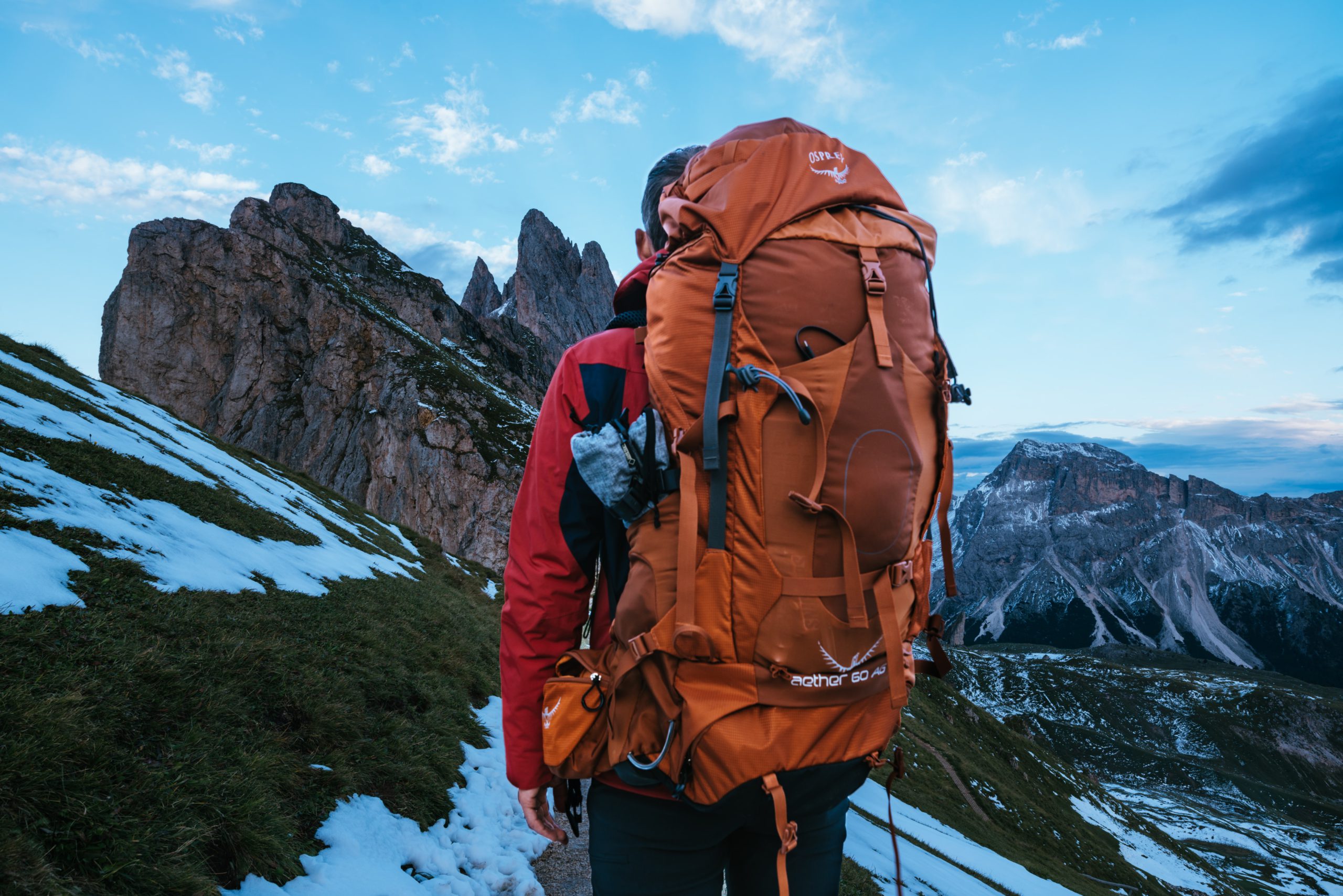Travel makes one modest. You see what a tiny place you occupy in the world.
― Gustav Flaubert

This guide teaches you how to choose the appropriate pack for your needs. It has details about your options and the situations best suited for each type of luggage. It compares the pros and cons of backpacks vs suitcases vs duffle bags.
Big companies like to hype up the backpack; they call it “backpacking” and we all instantly think of far away places and grand adventures. But with the hype can come anxiety about making the right choice: What is the best backpacking backpack? How do I find the right luggage for me? What is the best backpack for international travel? What kind of pack do I need for months of backpacking abroad in Asia, Europe, South America, and the world? Do I even need a backpack?
Three general types of packs that are useful for backpackers are the
Shoulder straps: By definition, a backpack has shoulder straps so you can carry it on your back. Carrying your luggage off the ground means you can take it anywhere. It also helps protect it from street grime.
Pockets: Most backpacks have assorted pockets that make keeping things organized a breeze.
Collapsable: Manu backpacks have straps that can be used to collapse any spare capacity and thereby decrease it’s overall size, making it easier to maneuver when not full.
Bulky and unruly: A backpack is not compact. It is usually oblong in shape with protruding straps and/or a hip belt. Those can make using public transportation a nightmare: backpacks rarely fit overhead or under seats because of their weird shape.
Expensive: Many backpacks from top brands come with a hefty price tag.
Stereotypes: Carrying the classic backpack immediately pins you as a traveller. It can make you a target for higher prices and even scams.
The final verdict on backpacks
The backpack is the best option for travellers that plan to walk long distances over rough terrain, such as hikers. If that is not your situation, consider another option. A backpack is recommended for the beaches of Central America and parts of South America (Chile, Argentina, and the Amazon delta). A backpack is not the recommended selection for Europe or East Africa.
A suitcase has a hinged lid and is essentially a travel box. In 1972, someone thought to put wheels on, and it’s been the most popular luggage option ever since.
Convenient: Suitcases are easy to open and often have partitions for organizing its contents.
Easy: The wheels on a suitcase make it easy to move around. They also take most of the weight for you, requiring less overall effort.
Durable: A range of case materials are available, from hard metal to sturdy cloth. They tend to do a better job of protecting fragile items.
Expandable: Almost all modern suitcases come with a way to extend the sides to increase volume. It’s a great feature to accommodate a growing souvenir collection.
Heavy: The additional elements within a suitcase, such as the handles and wheels, add to the overall weight.
Inflexible: Most suitcases have rigid outer shells. They are the shape they are, they cannot be squashed into oddly shaped spaces.
Clearance: Many suitcases are low to the ground, so if you encounter rough terrain, you may be forced to carry them. Similarly, they are terrible in sand. Those situations, however, are less common than most people suspect.
Sometimes the simplest option is the best one: suitcases are convenient and practical. They are best for those who prefer ease of use in terms of movement and access to contents. They are recommended for Europe, Australia, Antarctica, and any developed nations. They are not recommended for areas with rough terrain such as East Africa.
Many people use a duffle bag for the gym, or sometimes for a weekend away. But they may be a backpacker’s best friend during a long trip.
Convenient: Duffles usually have a large opening along the top so you can access everything.
Collapsable: Because most duffles do not have a rigid structure, they can collapse down when not full and be arranged into a variety of tight spaces.
Streamline: Duffle bags have fewer frills, like pockets and bulky straps, so their shapes are more streamline. They are the easiest option to fit in an overhead bin or under a seat.
Straps: Every duffle has carrying straps, but it’s important to consider the right one for you. A long strap allows a duffle to be slung across the body, but is more likely to get caught on something. Shorter straps are designed for carrying a duffle by hand, but if you are dexterous enough, you can slip them over your shoulders and wear them as shoulder straps, effectively making your duffle into a backpack. It’s not ideally comfortable for long periods, but is great for trips between your hostel and the bus station.
Affordable: While backpacks and suitcases frequently start above the $100 mark, it’s possible to get a high quality duffle bag for much less than than.
Camouflage: Having a duffle bag doesn’t immediately immediately shout “tourist.” So don’t be surprised when people start asking you for directions.
Few Pockets: Most duffles have 2-3 pockets. They are not ideal if you want to separate lots of little items.
No Frame: Duffles are basically cloth, so they lack internal frames to distribute the weight.
Duffles are the hidden gem of the backpacking world. They fill the sweet spot between accessibility and versatility.
Duffle bags are recommended for: everywhere.
No matter what type of bag you select, there are several universal features to consider.
Volume: For most, around 50L is enough. 60L is more than enough for if you plan to buy a lot of souvenirs. When travelling to colder climates, however, you may need up to 70L if you are bringing a lot of specialized gear, like a large jacket, sleeping bag, or tent. Make sure your bag will have enough space: figure out what you need first, measure how much space those supplies take up, and then shop for a bag.
Durability: It goes without saying that your bag will get a lot of wear and tear. Most of its life will actually be spent sitting peacefully at the hostel, but it does need to be sturdy enough to survive a 42 hour bus ride. So do you, for that matter.
Weight: There is a balance between durability and weight. Luggage made of wood and iron is durable, but unless you're hauling Spanish doubloons, opt for something lighter, even if it means sacrificing a smidgen of durability.
Waterproofing: Your bag will need to be waterproof, or at least resistant. Some packs include waterproofing, via its material or a rainfly, but many do not. If you protect your gear with nothing but a trash bag, great! Just make sure you have some way to waterproof it, and factor that cost into the total price.
Warranty: A warranty protects against defaults and malfunctions. It may not help you during your trip, but it allows you to replace anything once you get back.
Security Features: Impenetrable material and key/combination locks are some ways packs deter thieves. While no method is 100% guaranteed, it is recommended your pack have some security, even if it is just added loops on the zippers where you can put your own lock.
Unlike the clever marsupials, humans do not possess anatomical pouches to carry things. However, humans are notable for their highly dexterous phalanges. These digits allow them to manipulate tools precisely. Hence, they rely on their tools-using abilities to create packs.
A human of the subspecies “backpacker” may be identified by the possession of a specific type of pack that has shoulder straps and is carried on one’s back. This type of bag is commonly referred to a backpack, knapsack, or rucksack. Wanderlustable humans do not have to manufacture their own pack: Due to the global marketplace- a relatively new human construct- there are countless options. In fact, one does not need to specifically carry a backpack to be considered a “backpacker”, and in many situations, another type of pack may be more appropriate.
There is not one right bag for you.
While the backpack is the forever classic choice for a “backpacker”, there are more options. Backpacks, suitcases, and duffle bags are widely available in any major department, outdoor, and sporting goods store. Consider physically inspecting a range of options before choosing the right one for you. While you shop, come back and reference this list if you need to.
Disclosure: This post may contain affiliate links, meaning at no additional cost to you, I will earn a commission or compensation if you click through and/or make a purchase. The opinions and recommendations expressed here are my own.





I've had the travel bug for as long as I can remember. My hope is that I can help others find their own adventure.
Travel makes one modest. You see what a tiny place you occupy in the world.
― Gustav Flaubert
